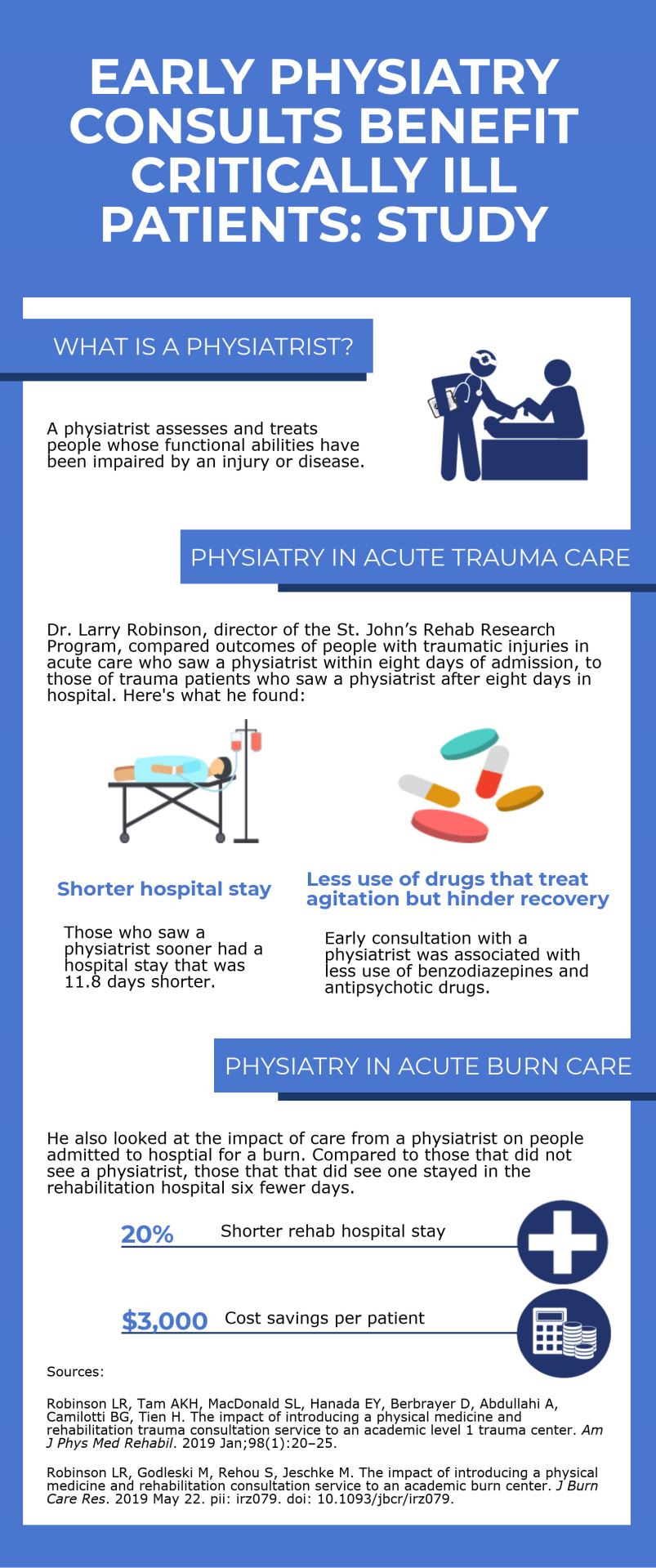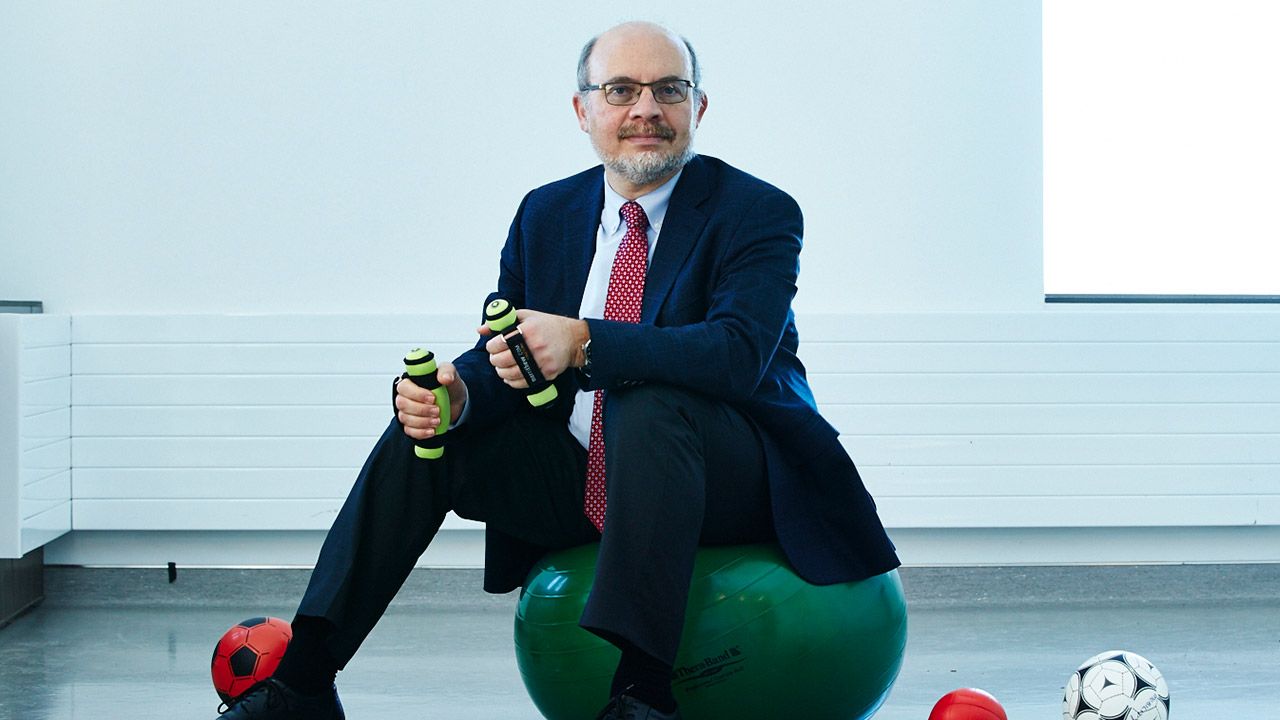Early physical medicine and rehabilitation consults benefit critically injured patients: study
As a medical student, Dr. Larry Robinson considered specializing in neurology or psychiatry. Then he found his path. “I ultimately chose physical medicine and rehabilitation, because I thought we could have an impact on almost everyone we encounter—not necessarily [on] curing them, but a positive impact in terms of improving function,” says Robinson, a senior scientist in and director of the St. John’s Rehab Research Program at Sunnybrook Research Institute (SRI).
Physical medicine and rehabilitation doctors, called physiatrists, evaluate and treat people whose functional abilities, like dressing, walking and self care have been impaired. These impairments can result from conditions like stroke, musculoskeletal disorders, spinal cord injuries, burns and trauma.
Robinson is chief of rehabilitation services at Sunnybrook. As one of two major trauma centres in the Greater Toronto Area (the other is St. Michael’s Hospital), Sunnybrook admits between 800 and 1,000 severely injured people annually. He studies the impact of early physical medicine and rehabilitation consultation on people treated for traumatic injuries at Sunnybrook.
In a recent study, he and his colleagues found that consultation with a physiatrist within eight days of admission was associated with a shorter stay, fewer complications and less use of benzodiazepines and antipsychotics. These drugs, while good at keeping patients calm, can hinder learning in the long term. Physiatrists generally discourage use of them as it can impede recovery. The study was published on Jan. 1, 2019 in the Journal of Physical Medicine & Rehabilitation.
In the study, the team initially compared outcomes of trauma patients in acute care who did not receive treatment from a physiatrist, with those of trauma patients who did receive treatment. There were no significant differences between the two groups in length of stay, readmissions or complications.
Where meaningful differences emerged, however, was in outcomes of trauma patients in acute care who saw a physiatrist within eight days of admission, and those of patients who saw one after eight days in hospital. On average, trauma patients who saw a physiatrist sooner had a length of stay that was 11.8 days shorter. The severity of injury was similar between the two groups.
The findings led to Sunnybrook increasing the number of physiatry consults in acute care, converting the single part-time position into a full-time one. Moreover, Robinson is working with St. Michael’s Hospital to recruit a physiatrist for its trauma program on the basis of the research.
“This study suggests that there’s no financial drain; in fact, there’s probably financial benefit to have the consultant see the patients early on—it’s associated with earlier discharge from acute care and maybe less complications,” says Robinson, who was recently recognized with a Five-Year Exceptional Leadership award as director of the division of physical medicine and rehabilitation at U of T.
This July marks Robinson’s fifth-year anniversary at Sunnybrook and, when he officially will become a Canadian citizen. Originally from the U.S., he was recruited from the University of Washington, where he worked for 25 years.
He has also published a study co-authored by SRI senior scientist Dr. Marc Jeschke on the impact of physiatry on people admitted to hospital for burns. The research compared outcomes before and after the introduction of physical medicine and rehabilitation consultation to Sunnybrook’s acute burn care program.
Robinson and colleagues found that while the addition of a burn physiatrist did not shorten burn patients’ length of stay in acute care, it significantly reduced length of stay in the rehabilitation hospital. Compared to the 109 people who did not see a physiatrist after their burn injury, the 104 burn patients who received physical medicine and rehabilitation stayed in the rehabilitation hospital six fewer days (24 versus 30 days).
“It looks like having the burn physiatrist involved does improve efficiency for our rehab stay. Patients generally want to get home sooner, and don’t want to stay in the hospital any longer than they need to. Plus, it saves cost—at $500 per day, that’s $3,000 per patient,” says Robinson of the study, which was published on May 22, 2019 in the Journal of Burn Care & Research.
Ultimately, he says, integrating physiatry into acute care is better for patients because it eases the transition to an in-patient rehabilitation facility. “Transitions are points of risk in any patient’s journey. By bringing the physiatrist into acute care, we can start the patient’s and family’s rehabilitation earlier and help them know what to expect in in-patient rehab. We can start to prepare the groundwork for their rehab by keeping them off drugs that would be a problem, maintaining their range of motion and starting strengthening programs. So it’s not a distinct time in acute care, and a distinct time in rehab; it’s really a continuum,” he says.

Read text-only version of above infographic
Early physiatry consults benefit critically ill patients: study
What is a physiatrist?
A physiatrist assesses and treats people whose functional abilities have been impaired by an injury or disease.
Physiatry in acute trauma care
Dr. Larry Robinson, director of the St. John’s Rehab Research Program, compared outcomes of people with traumatic injuries in acute care who saw a physiatrist within eight days of admission, to those of trauma patients who saw a physiatrist after eight days in hospital. Here’s what he found:
Shorter hospital stay: Those who saw a physiatrist sooner had a hospital stay that was 11.8 days shorter.
Less use of drugs that treat agitation but hinder recovery: Early consultation with a physiatrist was associated with less use of benzodiazepines and antipsychotic drugs.
Physiatry in acute burn care
He also looked at the impact of care from a physiatrist on people admitted to hospital for a burn. Compared to those that did not see a physiatrist, those that did see one stayed in the rehabilitation hospital six fewer days.
20% shorter rehab hospital stay
$3,000 cost savings per patient
Sources:
Robinson LR, Tam AKH, MacDonald SL, Hanada EY, Berbrayer D, Abdullahi A, Camilotti BG, Tien H. The impact of introducing a physical medicine and rehabilitation trauma consultation service to an academic level 1 trauma center. Am J Phys Med Rehabil. 2019 Jan;98(1):20–25.
Robinson LR, Godleski M, Rehou S, Jeschke M. The impact of introducing a physical medicine and rehabilitation consultation service to an academic burn center. J Burn Care Res. 2019 May 22. pii: irz079. doi: 10.1093/jbcr/irz079.
Robinson’s research is funded by an AFP Innovation Fund from the Ontario Ministry of Health and Long-Term Care. He holds the John and Sally Eaton Chair in Rehabilitation Science.
Original articles:
Robinson LR, Tam AKH, MacDonald SL, Hanada EY, Berbrayer D, Abdullahi A, Camilotti BG, Tien H. The impact of introducing a physical medicine and rehabilitation trauma consultation service to an academic level 1 trauma center. Am J Phys Med Rehabil. 2019 Jan;98(1):20-25.
Robinson LR, Godleski M, Rehou S, Jeschke M. The impact of introducing a physical medicine and rehabilitation consultation service to an academic burn center. J Burn Care Res. 2019 May 22. pii: irz079. doi: 10.1093/jbcr/irz079.
In a nutshell
- Dr. Larry Robinson has shown that among people with traumatic injuries, early consultation with a physiatrist (physical medicine and rehabilitation doctor) is associated with a shorter hospital stay.
- He has also found that people with burns who see a physiatrist during their acute care subsequently spend six fewer days in the rehabilitation hospital.
- Sunnybrook and St. Michael’s Hospital, which care for the province’s most critically injured patients, are integrating more consultations with physiatrists into their acute trauma care programs as a result of this research.



